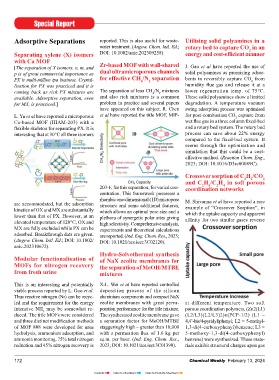Page 172 - CW E-Magazine (13-2-2024)
P. 172
Special Report
Adsorptive Separations reported. This is also useful for waste- Utilising solid polyamines in a
water treatment. (Angew. Chem. Intl. Ed.; rotary bed to capture CO in an
2
Separating xylene (X) isomers DOI: 10.1002/anie.202309258). energy and cost-efficient manner
with Ca MOF
[The separation of X isomers, o, m, and Zr-based MOF with wall-shared J. Gao et al have reported the use of
p is of great commercial importance as dual ultramicroporous channels solid polyamines as promising adsor-
PX is multi-million tpa business. Crystal- for effective CH /N separation bents to reversibly capture CO from
4
2
2
lisation for PX was practiced and it is humidity flue gas and release it at a
coming back as rich PX mixtures are The separation of lean CH /N mixtures lower regeneration temp. of 75°C.
2
4
available. Adsorptive separation, even and also rich mixtures is a common These solid polyamines show a limited
for MX, is practiced.] problem in practice and several papers degradation. A temperature vacuum
have appeared on this subject. R. Chen swing adsorption process was optimised
L. Yu et al have reported a microporous et al have reported the title MOF, MIP- for post-combustion CO capture from
2
Ca-based MOF (HIAM-203) with a wet flue gas in a three column fixed-bed
flexible skeleton for separating PX. It is and a rotary bed system. The rotary bed
interesting that at 30°C all three isomers process can save about 22% energy
compared to the fixed-bed system. It
seems through the optimisation and
simulation that this could be a cost-
effective method. (Reaction Chem. Eng.,
2023; DOI: 10.1016/D3re00089C).
Crossover sorption of C H /CO
2
2
2
and C H /C H in soft porous
2
6
4
2
203-F, for this separation, for varied con- coordination networks
centration. This framework possesses a
rhombic one-dimensional (1D) micropore
are accommodated, but the adsorption structure and some additional features, M. Shivanna et al have reported a rare
kinetics of OX and MX are substantially which allows an optimal pore size and a example of “Crossover Sorption”, in
lower than that of PX. However, at an plethora of synergetic polar sites giving which the uptake capacity and apparent
elevated temperature of 120°C, OX and high selectivity. Comprehensive analysis, affinity for two similar gases reverse
MX are fully excluded while PX can be experiments and theoretical calculations
adsorbed. Breakthrough data are given. are reported. (Ind. Eng. Chem. Res., 2023;
(Angew. Chem. Intl. Ed.; DOI: 10.1002/ DOI: 10.1021/acs.iecr.3C02120).
anie.202310672).
Hydro-Solvothermal synthesis
Modular functionalisation of of NaX zeolite membranes for
MOFs for nitrogen recovery the separation of MeOH/MTBE
from fresh urine mixtures
This is an interesting and potentially X-L. Wei et al have reported controlled
viable process reported by L. Guo et al. deposition process of the silicon
Thus reactive nitrogen (Nr) can be recyc- aluminium components and compact NaX
led and the requirement for the energy zeolite membranes with great perva- at different temperature. Two soft
intensive NH may be somewhat re- poration performance for the title mixture. porous coordination polymers, (Zn2(L1)
3
duced. The title MOFs were considered The synthesized zeolite membrane gave (L2/L3)(L2/L3)2)n(PCP-1/2) (L1 =
and three distinct modification methods a separation factor for MeOH/MTBE 4,4’-bis/4-pyridyl)phenyl; L2 = 5-methyl-
of MOF 808 were developed for urea staggeringly high – greater than 10,000 1,3-di(4-carboxyphenyl)benzene; L3 =
hydrolysis, ammonium adsorption, and with a permeation flux of 1.6 kg per 5-methoxy-1,3-di(4-carboxyphenyl)
ammonia monitoring. 75% total nitrogen sq.m. per hour. (Ind. Eng. Chem. Res., benzene) were synthesized. These mate-
reduction and 45% nitrogen recovery is 2023; DOI: 10.1021/acs.iecr.3C01390). rials exhibit structural charges upon gas
172 Chemical Weekly February 13, 2024
Contents Index to Advertisers Index to Products Advertised

